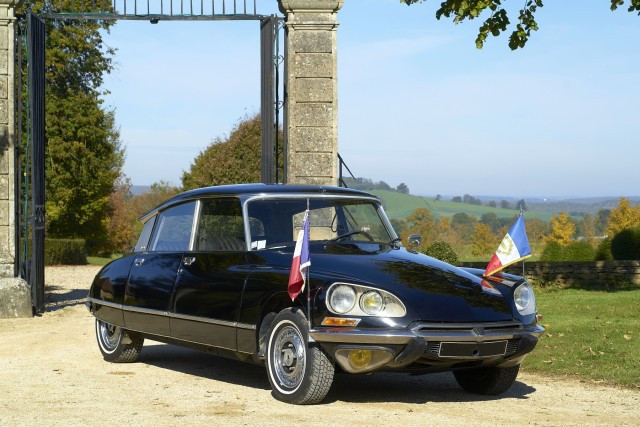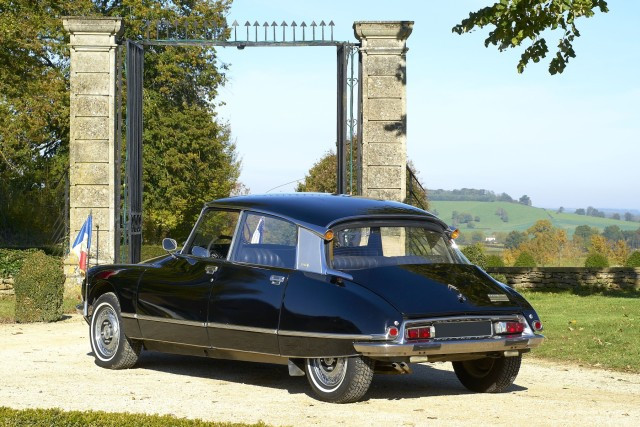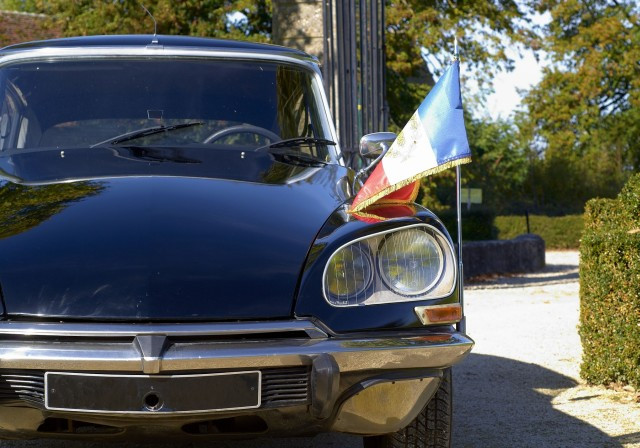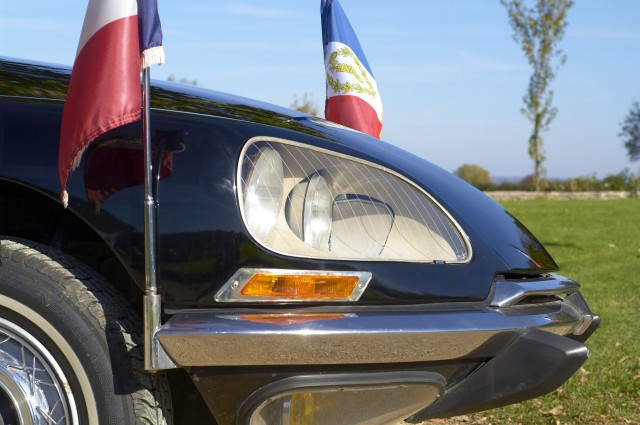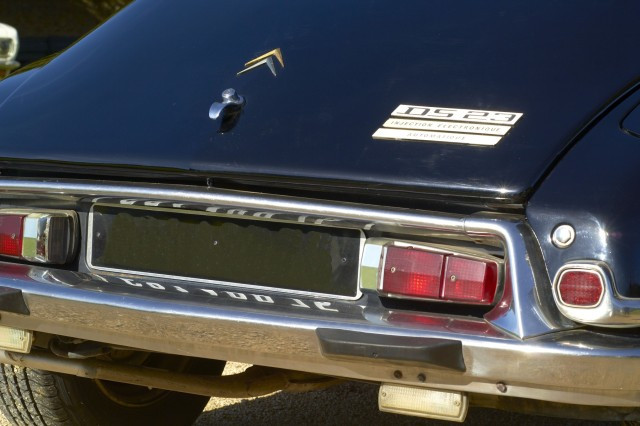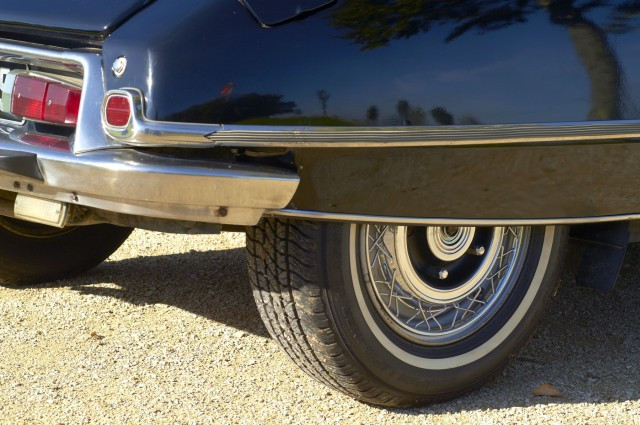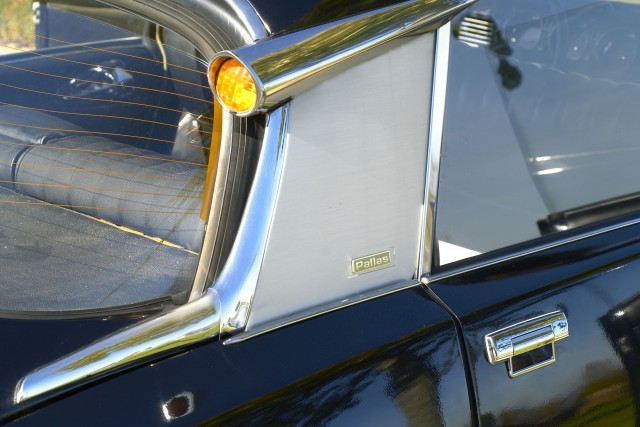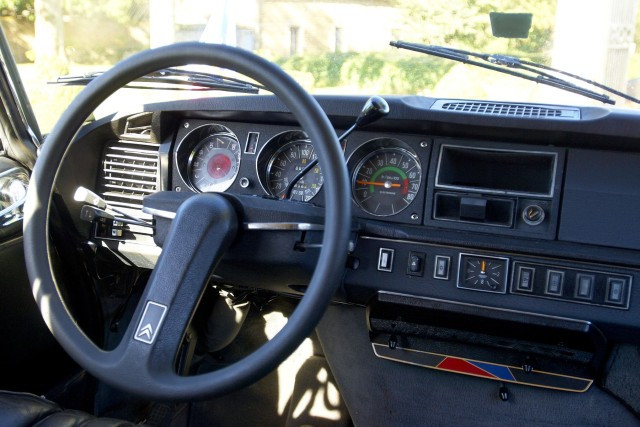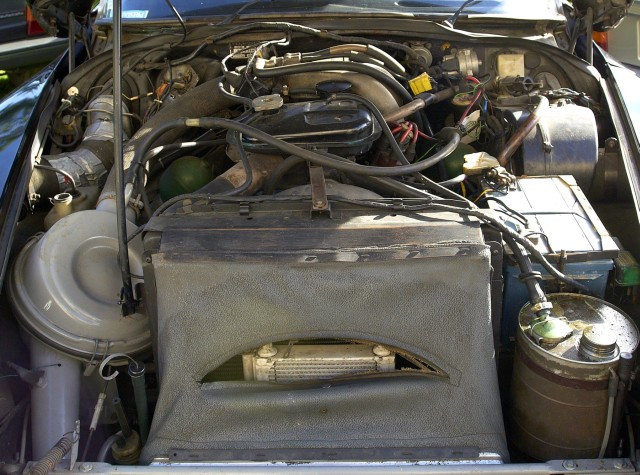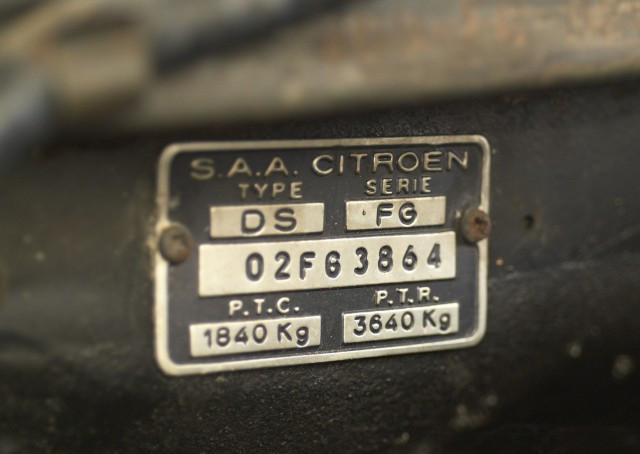Sale Rétromobile - 04 february 2011 /Lot 291 1974 CITROËN DS23 i.e. PALLAS - NO RESERVE
1974 CITROËN DS23 i.e. PALLAS - NO RESERVE Ex Présidence de la République
Châssis n° FG 02 3864
Moteur DX5 n° 0683017939
Lorsqu'elle est dévoilée au Grand Palais en octobre 1955, la nouvelle et très attendue Citroën DS 19 arrache au public présent une clameur de surprise et d'étonnement. Par son style et sa technologie, elle ne ressemble à rien de ce qui l'a précédée, ni aux modèles contemporains, même les plus luxueux. Ses suspensions, sa direction, son freinage et sa boîte de vitesses semi automatique, qui fonctionnent à partir d'une centrale hydraulique à très haute pression, sont sans précédent. Elle obtient auprès du public un succès phénoménal, concrétisé par des milliers de commandes passées dès le premier jour. Pourtant son moteur déçoit. Il découle d'un bloc conçu en 1934 pour la célèbre Traction et malgré l'adoption d'une culasse hémisphérique en alliage léger, ses 75 ch peinent à emmener la DS à 140 km/h. Elle doit pourtant à son aérodynamique des consommations très raisonnables et ses niveaux de confort et de comportement dynamique deviennent instantanément une référence. Malgré de nombreux problèmes dus à des solutions techniques d'avant-garde encore perfectibles, la DS aura très tôt ses fanatiques auxquels Citroën va offrir une voiture sans cesse améliorée tout au long de ses vingt ans de carrière. En 1960, le moteur est porté à 83 ch, mais il s'agit toujours du bon vieux deux litres 78 x 100 mm qui atteint ses limites. En 1965, un nouveau bloc à course courte (86 x 85,5) permet d'augmenter le régime maximal et d'obtenir 90 ch, puis en 1966, le " 21 " (90 x 85,5 mm) métamorphose la DS avec ses 109 puis ses 115 ch avant que la version à injection de 139 ch apparue en 1970 ne range officieusement la DS 21 parmi les " plus de 200 km/h ", vitesse qu'elle peut atteindre dans certaines circonstances. En 1972, la DS 23 à moteur 2,3 litres (93,5 x 85,5 mm) délivrant 141 ch avec l'injection électronique Bosch (réf. DX5) se classe parmi les routières les plus rapides, les plus confortables et les plus sûres du monde. C'est avec cette mécanique éprouvée que la DS achève sa carrière en 1975 en versions carburateur ou injection. Depuis septembre 1970, la DS 21 " mécanique " était équipée d'une boîte à cinq rapports et en novembre 1972, une boîte entièrement automatique Borg-Warner à trois rapports fut proposée en option. Ces types de transmission seront repris sur la DS 23.
En 1958, Citroën avait proposé la DS version Prestige, limousine construite sur commande et carrossée par Henri Chapron, avec une séparation chauffeur et une foule d'équipements optionnels. La Prestige fut offerte jusqu'en septembre 1974. Lorsqu'en 1964, Citroën introduisit la version optionnelle Pallas de la DS 19, qui offrait des finitions extérieures et intérieures plus luxueuses ou plus élégantes, la Prestige en bénéficia également. Extérieurement, outre de nombreux autres détails de finition et d'équipement, une Pallas est identifiable instantanément par sa bande protectrice latérale en acier inox avec insert caoutchouc qui court sur le pli des portes en rejoignant le réflecteur arrière. Ce niveau de finition fut ensuite proposé sur les DS 20, 21 et 23 jusqu'à l'arrêt de la production.
La voiture proposée est une DS 23 i.e. série FG de 1974 avec moteur DX5, boîte automatique et finition Pallas dont la carrosserie noire a été repeinte il y a une dizaine d'années. L'intérieur est noir avec sellerie en cuir noir en bon état d'origine comme les moquettes. Les vitres sont manuelles. Elle possède naturellement les phares intérieurs directionnels introduits fin 1967 en option sur les DS, mais standard sur les Pallas.
Comme l'attestent les documents qui l'accompagnent, et notamment l'ancienne carte grise et une lettre du Président Valéry Giscard d'Estaing adressée à l'actuel propriétaire, elle a appartenu au parc de l'élysée. Elle a ensuite figuré dans la Collection Philippe Charbonneaux avant son acquisition il y a environ 25 ans par l'actuel propriétaire qui l'a régulièrement utilisée. Affichant actuellement 88 024 km au compteur, elle a bénéficié en 1992 à 86 373 km de divers travaux d'entretien attestés par la facture figurant au dossier. Les quatre pneus (en bon état) datent de 2001 et les roues comportent des enjoliveurs Robergel à rayons.
Les sphères et le ciel de toit viennent d'être remplacés en 2010.
Carte grise normale au nom du précédent propriétaire.
When unveiled at the Grand Palais in October 1955, the new and long awaited Citroën DS19 drew a gasp of surprise and awe from the public who attended. There was nothing in its style and technology that resembled anything that had gone before, even the most luxurious contemporary models. Its suspension, steering, brakes and semi-automatic gearbox, which operated using a very high pressure hydraulic system, were unprecedented. It was a phenomenal success with the public, consolidated by thousands of orders made from the first day onwards.
However, its engine was disappointing. It was developed from a block designed in 1934 for the celebrated Traction and despite the adoption of a hemispherical light alloy cylinder head, its 75bhp struggled to propel the DS to 140km/h. However, due to its aerodynamics it had very reasonable fuel consumption and its levels of comfort and dynamic handling instantly became the standard.
Despite numerous problems due to the cutting edge techniques used that had still to be perfected, the DS had its devotees from the very beginning to whom Citroën offered cars that were continuously developed over the whole of its twenty year career.
In 1960, the engine was uprated to 83bhp, but it was still the same story with a 2 litre engine (78 x 100mm) which had its limits. In 1965, a new short stroke block (86 x 85.5mm) increased the maximum running speed and put out 90bhp. Then, in 1966, the "21" (90 x 85.5mm) metamorphosed the DS with 109bhp then 115bhp before the injection version with 139bhp appeared in 1970 which officially put the DS21 into the "over 200km/h speed" club, a speed that it could reach in certain conditions. In 1972, the DS23 with a 2.3 litre (93.5x85.5mm) engine outputting 141bhp with Bosch electronic injection (ref. DX5) was classed as one of the fastest, most comfortable and safest tourers in the world.
With these proven mechanicals, the DS ended its career in 1975 with carburetor or injection versions. In September 1970, the DS21 "mechanic" was fitted with a five speed gearbox and in November 1972 a fully automatic Borg-Warner three speed gearbox was offered as an option. These types of transmission were carried over to the DS23.
In 1958, Citroën offered the DS Prestige version, a limousine built to order and with coachwork by Henri Chapron, with separate driver's cabin and a host of optional equipment. The Prestige was offered up to September 1974. When in 1964 Citroën introduced the optional Pallas version of the DS19, which offered more luxurious or more elegant interior and exterior fittings, the Prestige also received them.
Externally, apart from numerous other detailed fittings and equipment, a Pallas is instantly recognisable from its side protective strip in stainless steel with rubber insert which runs over the door lines right to the rear reflector. This level of finish was then offered on the DS20, DS21 and DS23 up until the end of production.
The car offered for sale is a DS 23 i.e. FG 1974 Series with DX5 engine, automatic gearbox and Pallas finish whose black coachwork was repainted about twelve years ago. The interior is black with black leather upholstery in good original condition, like the carpets. The windows are manual. Naturally, it possesses the interior directional headlamps introduced at the end of 1967 as an option of the DS, but as standard on the Pallas.
As shown by the accompanying documents and in particular by the old vehicle registration document [the carte grise] and a letter from President Valéry Giscard d'Estaing sent to the current owner, it belonged to the fleet of the Elysée Palace. It then appeared in the Philippe Charbonneaux Collection before it was bought about 25 years ago by the current owner who has used it regularly.
Currently indicating 88,024 km on the odometer, in 1992 when at 86,373 km various maintenance works were carried out as shown on the invoice included in the file. The four tyres (in good condition) date from 2001 and the wheels include Robergel spoke hubcaps. The interior lights and the ceiling were replaced in 2010.
Normal vehicle registration document [carte grise] in the name of the previous owner.
Estimation 20 000 - 40 000 €
Sold 37,741 €
* Results are displayed including buyer’s fees and taxes. They are generated automatically and can be modified.
Châssis n° FG 02 3864
Moteur DX5 n° 0683017939
Lorsqu'elle est dévoilée au Grand Palais en octobre 1955, la nouvelle et très attendue Citroën DS 19 arrache au public présent une clameur de surprise et d'étonnement. Par son style et sa technologie, elle ne ressemble à rien de ce qui l'a précédée, ni aux modèles contemporains, même les plus luxueux. Ses suspensions, sa direction, son freinage et sa boîte de vitesses semi automatique, qui fonctionnent à partir d'une centrale hydraulique à très haute pression, sont sans précédent. Elle obtient auprès du public un succès phénoménal, concrétisé par des milliers de commandes passées dès le premier jour. Pourtant son moteur déçoit. Il découle d'un bloc conçu en 1934 pour la célèbre Traction et malgré l'adoption d'une culasse hémisphérique en alliage léger, ses 75 ch peinent à emmener la DS à 140 km/h. Elle doit pourtant à son aérodynamique des consommations très raisonnables et ses niveaux de confort et de comportement dynamique deviennent instantanément une référence. Malgré de nombreux problèmes dus à des solutions techniques d'avant-garde encore perfectibles, la DS aura très tôt ses fanatiques auxquels Citroën va offrir une voiture sans cesse améliorée tout au long de ses vingt ans de carrière. En 1960, le moteur est porté à 83 ch, mais il s'agit toujours du bon vieux deux litres 78 x 100 mm qui atteint ses limites. En 1965, un nouveau bloc à course courte (86 x 85,5) permet d'augmenter le régime maximal et d'obtenir 90 ch, puis en 1966, le " 21 " (90 x 85,5 mm) métamorphose la DS avec ses 109 puis ses 115 ch avant que la version à injection de 139 ch apparue en 1970 ne range officieusement la DS 21 parmi les " plus de 200 km/h ", vitesse qu'elle peut atteindre dans certaines circonstances. En 1972, la DS 23 à moteur 2,3 litres (93,5 x 85,5 mm) délivrant 141 ch avec l'injection électronique Bosch (réf. DX5) se classe parmi les routières les plus rapides, les plus confortables et les plus sûres du monde. C'est avec cette mécanique éprouvée que la DS achève sa carrière en 1975 en versions carburateur ou injection. Depuis septembre 1970, la DS 21 " mécanique " était équipée d'une boîte à cinq rapports et en novembre 1972, une boîte entièrement automatique Borg-Warner à trois rapports fut proposée en option. Ces types de transmission seront repris sur la DS 23.
En 1958, Citroën avait proposé la DS version Prestige, limousine construite sur commande et carrossée par Henri Chapron, avec une séparation chauffeur et une foule d'équipements optionnels. La Prestige fut offerte jusqu'en septembre 1974. Lorsqu'en 1964, Citroën introduisit la version optionnelle Pallas de la DS 19, qui offrait des finitions extérieures et intérieures plus luxueuses ou plus élégantes, la Prestige en bénéficia également. Extérieurement, outre de nombreux autres détails de finition et d'équipement, une Pallas est identifiable instantanément par sa bande protectrice latérale en acier inox avec insert caoutchouc qui court sur le pli des portes en rejoignant le réflecteur arrière. Ce niveau de finition fut ensuite proposé sur les DS 20, 21 et 23 jusqu'à l'arrêt de la production.
La voiture proposée est une DS 23 i.e. série FG de 1974 avec moteur DX5, boîte automatique et finition Pallas dont la carrosserie noire a été repeinte il y a une dizaine d'années. L'intérieur est noir avec sellerie en cuir noir en bon état d'origine comme les moquettes. Les vitres sont manuelles. Elle possède naturellement les phares intérieurs directionnels introduits fin 1967 en option sur les DS, mais standard sur les Pallas.
Comme l'attestent les documents qui l'accompagnent, et notamment l'ancienne carte grise et une lettre du Président Valéry Giscard d'Estaing adressée à l'actuel propriétaire, elle a appartenu au parc de l'élysée. Elle a ensuite figuré dans la Collection Philippe Charbonneaux avant son acquisition il y a environ 25 ans par l'actuel propriétaire qui l'a régulièrement utilisée. Affichant actuellement 88 024 km au compteur, elle a bénéficié en 1992 à 86 373 km de divers travaux d'entretien attestés par la facture figurant au dossier. Les quatre pneus (en bon état) datent de 2001 et les roues comportent des enjoliveurs Robergel à rayons.
Les sphères et le ciel de toit viennent d'être remplacés en 2010.
Carte grise normale au nom du précédent propriétaire.
When unveiled at the Grand Palais in October 1955, the new and long awaited Citroën DS19 drew a gasp of surprise and awe from the public who attended. There was nothing in its style and technology that resembled anything that had gone before, even the most luxurious contemporary models. Its suspension, steering, brakes and semi-automatic gearbox, which operated using a very high pressure hydraulic system, were unprecedented. It was a phenomenal success with the public, consolidated by thousands of orders made from the first day onwards.
However, its engine was disappointing. It was developed from a block designed in 1934 for the celebrated Traction and despite the adoption of a hemispherical light alloy cylinder head, its 75bhp struggled to propel the DS to 140km/h. However, due to its aerodynamics it had very reasonable fuel consumption and its levels of comfort and dynamic handling instantly became the standard.
Despite numerous problems due to the cutting edge techniques used that had still to be perfected, the DS had its devotees from the very beginning to whom Citroën offered cars that were continuously developed over the whole of its twenty year career.
In 1960, the engine was uprated to 83bhp, but it was still the same story with a 2 litre engine (78 x 100mm) which had its limits. In 1965, a new short stroke block (86 x 85.5mm) increased the maximum running speed and put out 90bhp. Then, in 1966, the "21" (90 x 85.5mm) metamorphosed the DS with 109bhp then 115bhp before the injection version with 139bhp appeared in 1970 which officially put the DS21 into the "over 200km/h speed" club, a speed that it could reach in certain conditions. In 1972, the DS23 with a 2.3 litre (93.5x85.5mm) engine outputting 141bhp with Bosch electronic injection (ref. DX5) was classed as one of the fastest, most comfortable and safest tourers in the world.
With these proven mechanicals, the DS ended its career in 1975 with carburetor or injection versions. In September 1970, the DS21 "mechanic" was fitted with a five speed gearbox and in November 1972 a fully automatic Borg-Warner three speed gearbox was offered as an option. These types of transmission were carried over to the DS23.
In 1958, Citroën offered the DS Prestige version, a limousine built to order and with coachwork by Henri Chapron, with separate driver's cabin and a host of optional equipment. The Prestige was offered up to September 1974. When in 1964 Citroën introduced the optional Pallas version of the DS19, which offered more luxurious or more elegant interior and exterior fittings, the Prestige also received them.
Externally, apart from numerous other detailed fittings and equipment, a Pallas is instantly recognisable from its side protective strip in stainless steel with rubber insert which runs over the door lines right to the rear reflector. This level of finish was then offered on the DS20, DS21 and DS23 up until the end of production.
The car offered for sale is a DS 23 i.e. FG 1974 Series with DX5 engine, automatic gearbox and Pallas finish whose black coachwork was repainted about twelve years ago. The interior is black with black leather upholstery in good original condition, like the carpets. The windows are manual. Naturally, it possesses the interior directional headlamps introduced at the end of 1967 as an option of the DS, but as standard on the Pallas.
As shown by the accompanying documents and in particular by the old vehicle registration document [the carte grise] and a letter from President Valéry Giscard d'Estaing sent to the current owner, it belonged to the fleet of the Elysée Palace. It then appeared in the Philippe Charbonneaux Collection before it was bought about 25 years ago by the current owner who has used it regularly.
Currently indicating 88,024 km on the odometer, in 1992 when at 86,373 km various maintenance works were carried out as shown on the invoice included in the file. The four tyres (in good condition) date from 2001 and the wheels include Robergel spoke hubcaps. The interior lights and the ceiling were replaced in 2010.
Normal vehicle registration document [carte grise] in the name of the previous owner.
Estimation 20 000 - 40 000 €
Sold 37,741 €
* Results are displayed including buyer’s fees and taxes. They are generated automatically and can be modified.
Lot 291
1974 CITROËN DS23 i.e. PALLAS - NO RESERVE
Lot 291
Sold 37,741 € [$]
1974 CITROËN DS23 i.e. PALLAS - NO RESERVE Ex Présidence de la République
Châssis n° FG 02 3864
Moteur DX5 n° 0683017939
Lorsqu'elle est dévoilée au Grand Palais en octobre 1955, la nouvelle et très attendue Citroën DS 19 arrache au public présent une clameur de surprise et d'étonnement. Par son style et sa technologie, elle ne ressemble à rien de ce qui l'a précédée, ni aux modèles contemporains, même les plus luxueux. Ses suspensions, sa direction, son freinage et sa boîte de vitesses semi automatique, qui fonctionnent à partir d'une centrale hydraulique à très haute pression, sont sans précédent. Elle obtient auprès du public un succès phénoménal, concrétisé par des milliers de commandes passées dès le premier jour. Pourtant son moteur déçoit. Il découle d'un bloc conçu en 1934 pour la célèbre Traction et malgré l'adoption d'une culasse hémisphérique en alliage léger, ses 75 ch peinent à emmener la DS à 140 km/h. Elle doit pourtant à son aérodynamique des consommations très raisonnables et ses niveaux de confort et de comportement dynamique deviennent instantanément une référence. Malgré de nombreux problèmes dus à des solutions techniques d'avant-garde encore perfectibles, la DS aura très tôt ses fanatiques auxquels Citroën va offrir une voiture sans cesse améliorée tout au long de ses vingt ans de carrière. En 1960, le moteur est porté à 83 ch, mais il s'agit toujours du bon vieux deux litres 78 x 100 mm qui atteint ses limites. En 1965, un nouveau bloc à course courte (86 x 85,5) permet d'augmenter le régime maximal et d'obtenir 90 ch, puis en 1966, le " 21 " (90 x 85,5 mm) métamorphose la DS avec ses 109 puis ses 115 ch avant que la version à injection de 139 ch apparue en 1970 ne range officieusement la DS 21 parmi les " plus de 200 km/h ", vitesse qu'elle peut atteindre dans certaines circonstances. En 1972, la DS 23 à moteur 2,3 litres (93,5 x 85,5 mm) délivrant 141 ch avec l'injection électronique Bosch (réf. DX5) se classe parmi les routières les plus rapides, les plus confortables et les plus sûres du monde. C'est avec cette mécanique éprouvée que la DS achève sa carrière en 1975 en versions carburateur ou injection. Depuis septembre 1970, la DS 21 " mécanique " était équipée d'une boîte à cinq rapports et en novembre 1972, une boîte entièrement automatique Borg-Warner à trois rapports fut proposée en option. Ces types de transmission seront repris sur la DS 23.
En 1958, Citroën avait proposé la DS version Prestige, limousine construite sur commande et carrossée par Henri Chapron, avec une séparation chauffeur et une foule d'équipements optionnels. La Prestige fut offerte jusqu'en septembre 1974. Lorsqu'en 1964, Citroën introduisit la version optionnelle Pallas de la DS 19, qui offrait des finitions extérieures et intérieures plus luxueuses ou plus élégantes, la Prestige en bénéficia également. Extérieurement, outre de nombreux autres détails de finition et d'équipement, une Pallas est identifiable instantanément par sa bande protectrice latérale en acier inox avec insert caoutchouc qui court sur le pli des portes en rejoignant le réflecteur arrière. Ce niveau de finition fut ensuite proposé sur les DS 20, 21 et 23 jusqu'à l'arrêt de la production.
La voiture proposée est une DS 23 i.e. série FG de 1974 avec moteur DX5, boîte automatique et finition Pallas dont la carrosserie noire a été repeinte il y a une dizaine d'années. L'intérieur est noir avec sellerie en cuir noir en bon état d'origine comme les moquettes. Les vitres sont manuelles. Elle possède naturellement les phares intérieurs directionnels introduits fin 1967 en option sur les DS, mais standard sur les Pallas.
Comme l'attestent les documents qui l'accompagnent, et notamment l'ancienne carte grise et une lettre du Président Valéry Giscard d'Estaing adressée à l'actuel propriétaire, elle a appartenu au parc de l'élysée. Elle a ensuite figuré dans la Collection Philippe Charbonneaux avant son acquisition il y a environ 25 ans par l'actuel propriétaire qui l'a régulièrement utilisée. Affichant actuellement 88 024 km au compteur, elle a bénéficié en 1992 à 86 373 km de divers travaux d'entretien attestés par la facture figurant au dossier. Les quatre pneus (en bon état) datent de 2001 et les roues comportent des enjoliveurs Robergel à rayons.
Les sphères et le ciel de toit viennent d'être remplacés en 2010.
Carte grise normale au nom du précédent propriétaire.
When unveiled at the Grand Palais in October 1955, the new and long awaited Citroën DS19 drew a gasp of surprise and awe from the public who attended. There was nothing in its style and technology that resembled anything that had gone before, even the most luxurious contemporary models. Its suspension, steering, brakes and semi-automatic gearbox, which operated using a very high pressure hydraulic system, were unprecedented. It was a phenomenal success with the public, consolidated by thousands of orders made from the first day onwards.
However, its engine was disappointing. It was developed from a block designed in 1934 for the celebrated Traction and despite the adoption of a hemispherical light alloy cylinder head, its 75bhp struggled to propel the DS to 140km/h. However, due to its aerodynamics it had very reasonable fuel consumption and its levels of comfort and dynamic handling instantly became the standard.
Despite numerous problems due to the cutting edge techniques used that had still to be perfected, the DS had its devotees from the very beginning to whom Citroën offered cars that were continuously developed over the whole of its twenty year career.
In 1960, the engine was uprated to 83bhp, but it was still the same story with a 2 litre engine (78 x 100mm) which had its limits. In 1965, a new short stroke block (86 x 85.5mm) increased the maximum running speed and put out 90bhp. Then, in 1966, the "21" (90 x 85.5mm) metamorphosed the DS with 109bhp then 115bhp before the injection version with 139bhp appeared in 1970 which officially put the DS21 into the "over 200km/h speed" club, a speed that it could reach in certain conditions. In 1972, the DS23 with a 2.3 litre (93.5x85.5mm) engine outputting 141bhp with Bosch electronic injection (ref. DX5) was classed as one of the fastest, most comfortable and safest tourers in the world.
With these proven mechanicals, the DS ended its career in 1975 with carburetor or injection versions. In September 1970, the DS21 "mechanic" was fitted with a five speed gearbox and in November 1972 a fully automatic Borg-Warner three speed gearbox was offered as an option. These types of transmission were carried over to the DS23.
In 1958, Citroën offered the DS Prestige version, a limousine built to order and with coachwork by Henri Chapron, with separate driver's cabin and a host of optional equipment. The Prestige was offered up to September 1974. When in 1964 Citroën introduced the optional Pallas version of the DS19, which offered more luxurious or more elegant interior and exterior fittings, the Prestige also received them.
Externally, apart from numerous other detailed fittings and equipment, a Pallas is instantly recognisable from its side protective strip in stainless steel with rubber insert which runs over the door lines right to the rear reflector. This level of finish was then offered on the DS20, DS21 and DS23 up until the end of production.
The car offered for sale is a DS 23 i.e. FG 1974 Series with DX5 engine, automatic gearbox and Pallas finish whose black coachwork was repainted about twelve years ago. The interior is black with black leather upholstery in good original condition, like the carpets. The windows are manual. Naturally, it possesses the interior directional headlamps introduced at the end of 1967 as an option of the DS, but as standard on the Pallas.
As shown by the accompanying documents and in particular by the old vehicle registration document [the carte grise] and a letter from President Valéry Giscard d'Estaing sent to the current owner, it belonged to the fleet of the Elysée Palace. It then appeared in the Philippe Charbonneaux Collection before it was bought about 25 years ago by the current owner who has used it regularly.
Currently indicating 88,024 km on the odometer, in 1992 when at 86,373 km various maintenance works were carried out as shown on the invoice included in the file. The four tyres (in good condition) date from 2001 and the wheels include Robergel spoke hubcaps. The interior lights and the ceiling were replaced in 2010.
Normal vehicle registration document [carte grise] in the name of the previous owner.
Estimation 20 000 - 40 000 €
Sold 37,741 €
* Results are displayed including buyer’s fees and taxes. They are generated automatically and can be modified.
Châssis n° FG 02 3864
Moteur DX5 n° 0683017939
Lorsqu'elle est dévoilée au Grand Palais en octobre 1955, la nouvelle et très attendue Citroën DS 19 arrache au public présent une clameur de surprise et d'étonnement. Par son style et sa technologie, elle ne ressemble à rien de ce qui l'a précédée, ni aux modèles contemporains, même les plus luxueux. Ses suspensions, sa direction, son freinage et sa boîte de vitesses semi automatique, qui fonctionnent à partir d'une centrale hydraulique à très haute pression, sont sans précédent. Elle obtient auprès du public un succès phénoménal, concrétisé par des milliers de commandes passées dès le premier jour. Pourtant son moteur déçoit. Il découle d'un bloc conçu en 1934 pour la célèbre Traction et malgré l'adoption d'une culasse hémisphérique en alliage léger, ses 75 ch peinent à emmener la DS à 140 km/h. Elle doit pourtant à son aérodynamique des consommations très raisonnables et ses niveaux de confort et de comportement dynamique deviennent instantanément une référence. Malgré de nombreux problèmes dus à des solutions techniques d'avant-garde encore perfectibles, la DS aura très tôt ses fanatiques auxquels Citroën va offrir une voiture sans cesse améliorée tout au long de ses vingt ans de carrière. En 1960, le moteur est porté à 83 ch, mais il s'agit toujours du bon vieux deux litres 78 x 100 mm qui atteint ses limites. En 1965, un nouveau bloc à course courte (86 x 85,5) permet d'augmenter le régime maximal et d'obtenir 90 ch, puis en 1966, le " 21 " (90 x 85,5 mm) métamorphose la DS avec ses 109 puis ses 115 ch avant que la version à injection de 139 ch apparue en 1970 ne range officieusement la DS 21 parmi les " plus de 200 km/h ", vitesse qu'elle peut atteindre dans certaines circonstances. En 1972, la DS 23 à moteur 2,3 litres (93,5 x 85,5 mm) délivrant 141 ch avec l'injection électronique Bosch (réf. DX5) se classe parmi les routières les plus rapides, les plus confortables et les plus sûres du monde. C'est avec cette mécanique éprouvée que la DS achève sa carrière en 1975 en versions carburateur ou injection. Depuis septembre 1970, la DS 21 " mécanique " était équipée d'une boîte à cinq rapports et en novembre 1972, une boîte entièrement automatique Borg-Warner à trois rapports fut proposée en option. Ces types de transmission seront repris sur la DS 23.
En 1958, Citroën avait proposé la DS version Prestige, limousine construite sur commande et carrossée par Henri Chapron, avec une séparation chauffeur et une foule d'équipements optionnels. La Prestige fut offerte jusqu'en septembre 1974. Lorsqu'en 1964, Citroën introduisit la version optionnelle Pallas de la DS 19, qui offrait des finitions extérieures et intérieures plus luxueuses ou plus élégantes, la Prestige en bénéficia également. Extérieurement, outre de nombreux autres détails de finition et d'équipement, une Pallas est identifiable instantanément par sa bande protectrice latérale en acier inox avec insert caoutchouc qui court sur le pli des portes en rejoignant le réflecteur arrière. Ce niveau de finition fut ensuite proposé sur les DS 20, 21 et 23 jusqu'à l'arrêt de la production.
La voiture proposée est une DS 23 i.e. série FG de 1974 avec moteur DX5, boîte automatique et finition Pallas dont la carrosserie noire a été repeinte il y a une dizaine d'années. L'intérieur est noir avec sellerie en cuir noir en bon état d'origine comme les moquettes. Les vitres sont manuelles. Elle possède naturellement les phares intérieurs directionnels introduits fin 1967 en option sur les DS, mais standard sur les Pallas.
Comme l'attestent les documents qui l'accompagnent, et notamment l'ancienne carte grise et une lettre du Président Valéry Giscard d'Estaing adressée à l'actuel propriétaire, elle a appartenu au parc de l'élysée. Elle a ensuite figuré dans la Collection Philippe Charbonneaux avant son acquisition il y a environ 25 ans par l'actuel propriétaire qui l'a régulièrement utilisée. Affichant actuellement 88 024 km au compteur, elle a bénéficié en 1992 à 86 373 km de divers travaux d'entretien attestés par la facture figurant au dossier. Les quatre pneus (en bon état) datent de 2001 et les roues comportent des enjoliveurs Robergel à rayons.
Les sphères et le ciel de toit viennent d'être remplacés en 2010.
Carte grise normale au nom du précédent propriétaire.
When unveiled at the Grand Palais in October 1955, the new and long awaited Citroën DS19 drew a gasp of surprise and awe from the public who attended. There was nothing in its style and technology that resembled anything that had gone before, even the most luxurious contemporary models. Its suspension, steering, brakes and semi-automatic gearbox, which operated using a very high pressure hydraulic system, were unprecedented. It was a phenomenal success with the public, consolidated by thousands of orders made from the first day onwards.
However, its engine was disappointing. It was developed from a block designed in 1934 for the celebrated Traction and despite the adoption of a hemispherical light alloy cylinder head, its 75bhp struggled to propel the DS to 140km/h. However, due to its aerodynamics it had very reasonable fuel consumption and its levels of comfort and dynamic handling instantly became the standard.
Despite numerous problems due to the cutting edge techniques used that had still to be perfected, the DS had its devotees from the very beginning to whom Citroën offered cars that were continuously developed over the whole of its twenty year career.
In 1960, the engine was uprated to 83bhp, but it was still the same story with a 2 litre engine (78 x 100mm) which had its limits. In 1965, a new short stroke block (86 x 85.5mm) increased the maximum running speed and put out 90bhp. Then, in 1966, the "21" (90 x 85.5mm) metamorphosed the DS with 109bhp then 115bhp before the injection version with 139bhp appeared in 1970 which officially put the DS21 into the "over 200km/h speed" club, a speed that it could reach in certain conditions. In 1972, the DS23 with a 2.3 litre (93.5x85.5mm) engine outputting 141bhp with Bosch electronic injection (ref. DX5) was classed as one of the fastest, most comfortable and safest tourers in the world.
With these proven mechanicals, the DS ended its career in 1975 with carburetor or injection versions. In September 1970, the DS21 "mechanic" was fitted with a five speed gearbox and in November 1972 a fully automatic Borg-Warner three speed gearbox was offered as an option. These types of transmission were carried over to the DS23.
In 1958, Citroën offered the DS Prestige version, a limousine built to order and with coachwork by Henri Chapron, with separate driver's cabin and a host of optional equipment. The Prestige was offered up to September 1974. When in 1964 Citroën introduced the optional Pallas version of the DS19, which offered more luxurious or more elegant interior and exterior fittings, the Prestige also received them.
Externally, apart from numerous other detailed fittings and equipment, a Pallas is instantly recognisable from its side protective strip in stainless steel with rubber insert which runs over the door lines right to the rear reflector. This level of finish was then offered on the DS20, DS21 and DS23 up until the end of production.
The car offered for sale is a DS 23 i.e. FG 1974 Series with DX5 engine, automatic gearbox and Pallas finish whose black coachwork was repainted about twelve years ago. The interior is black with black leather upholstery in good original condition, like the carpets. The windows are manual. Naturally, it possesses the interior directional headlamps introduced at the end of 1967 as an option of the DS, but as standard on the Pallas.
As shown by the accompanying documents and in particular by the old vehicle registration document [the carte grise] and a letter from President Valéry Giscard d'Estaing sent to the current owner, it belonged to the fleet of the Elysée Palace. It then appeared in the Philippe Charbonneaux Collection before it was bought about 25 years ago by the current owner who has used it regularly.
Currently indicating 88,024 km on the odometer, in 1992 when at 86,373 km various maintenance works were carried out as shown on the invoice included in the file. The four tyres (in good condition) date from 2001 and the wheels include Robergel spoke hubcaps. The interior lights and the ceiling were replaced in 2010.
Normal vehicle registration document [carte grise] in the name of the previous owner.
Estimation 20 000 - 40 000 €
Sold 37,741 €
* Results are displayed including buyer’s fees and taxes. They are generated automatically and can be modified.
Sale’s details
Sale: 1957
Date: 04 Feb. 2011 19:00
Date: 04 Feb. 2011 19:00
Contact
Absentee Bids
& Telephone Bids
Kristina Vrzests
Phone +33 1 42 99 20 51
bids@artcurial.com
